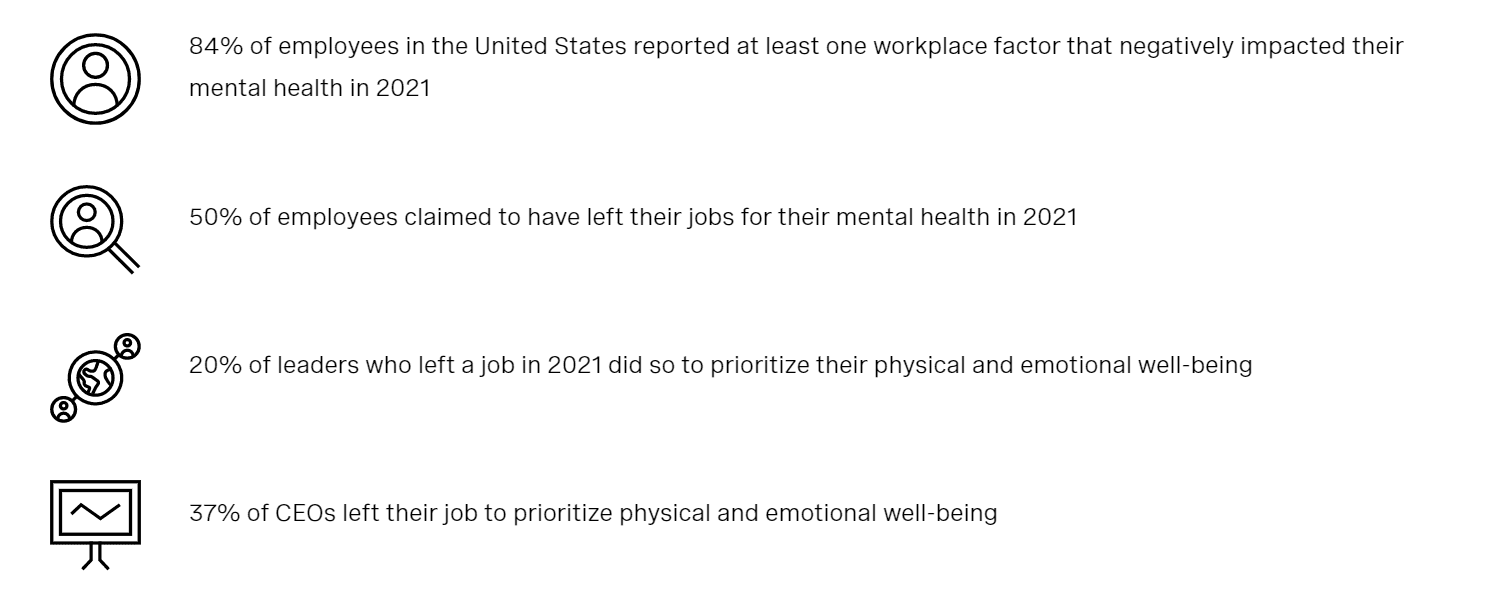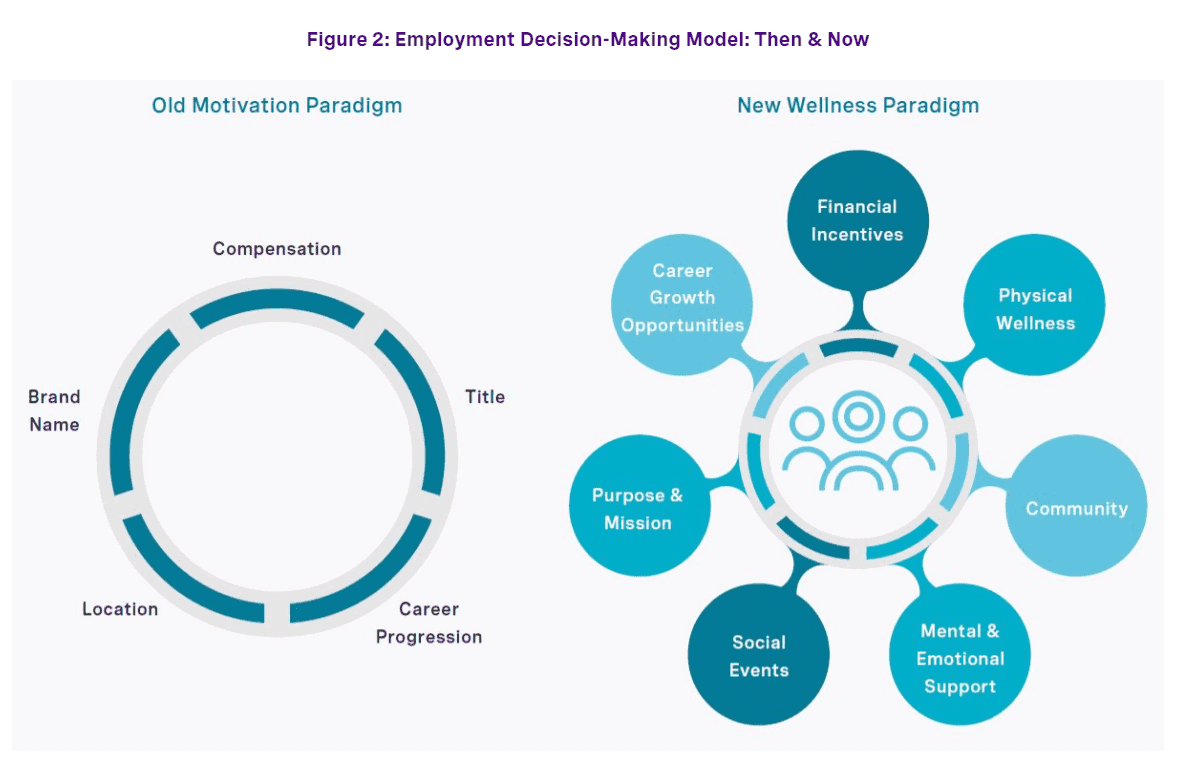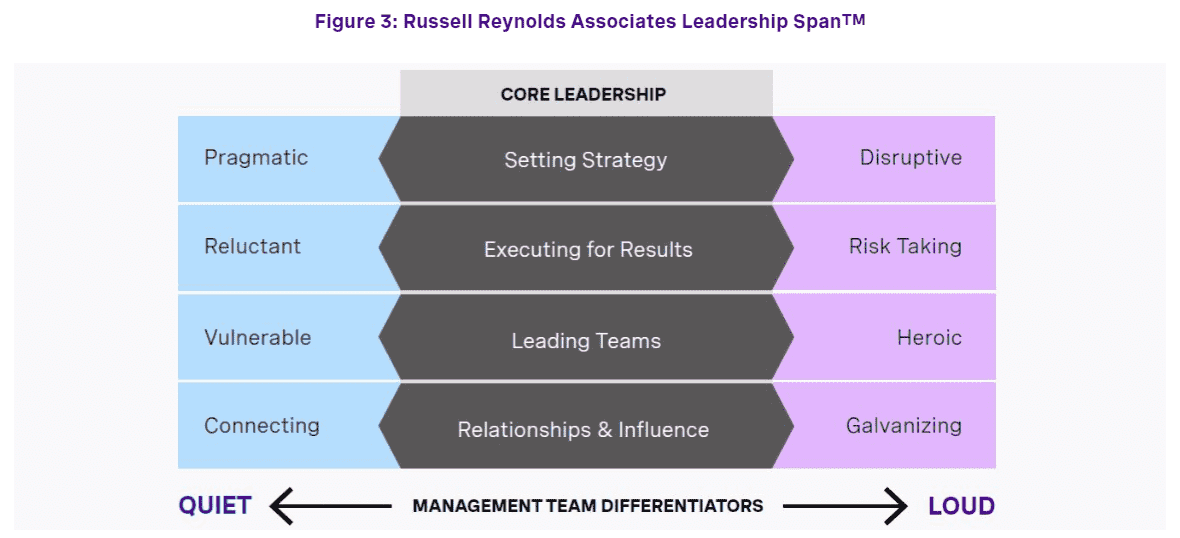How Leaders Can Improve Culture by Prioritizing Employee Well-Being
The Great Resignation, The Great Rethink, or The Great Reprioritization—regardless of the terminology you prefer, the reality is that we are living through a period unlike anything in the global history of work. To ensure your organization is equipped to handle these shifting times, prioritizing organizational culture by supporting employee well-being is crucial.
First: what is well-being? At Russell Reynolds Associates, we define it as the overall mental, physical, emotional, and economic health of employees. Well-being is influenced by various factors, including co-worker relationships, organizational purpose and mission, growth opportunities, and the tools and resources employees have access to.
Currently, overall employee well-being is in a dire state. According to non-profit organization Mind Share Partners, 84% of employees in the United States reported at least one workplace factor that negatively impacted their mental health in 2021. Furthermore, 50% of employees claimed to have left their jobs for their mental health in 2021.1 Comparatively, the question of why leaders move jobs is less examined. In our 2022 Global Leadership Monitor, which surveyed over 1,500 leaders across role, sector, and industry worldwide, Russell Reynolds found that 20% of leaders who left a job in 2021 did so to prioritize their physical and emotional well-being. Even more noteworthy: 37% of CEOs made the same choice. With continued reshuffling in 2022, these numbers will invariably increase among both junior and senior staff.

To understand how employees are feeling about their organization’s culture and the level of leadership support they are receiving regarding well-being, Russell Reynolds administered a global culture imaging survey that reached over 10,000 people over the past year. We also surveyed 87 global human resources leaders across all sectors. Overall, we learned that while executives are taking culture and employee wellness seriously, there is still a gap between intention and execution. To address this, we developed a leadership framework that centers wellness and, by extension, culture. This framework includes the following principles:
01 Your employee is your first customer
Investments and mindset shifts that support employee well-being, leading to increased customer satisfaction and community involvement
02 Leadership competencies
Behaviors and skills that support well-being at all seniority levels
03 Recommendations
How to incorporate wellness expertise into your leadership team and organizational strategy
There is a Gap Between Leadership and Employee Expectations Around Wellness
Recognizing the need to address culture concerns in this new way of working, HR leaders are taking steps to change how their organization prioritizes well-being. In our “2022 HR Leaders Global Wellness Survey” (N=87), 90% of respondents reported doing something differently in the past year to tackle employee well-being. This included (but was not limited to) well-being helplines, mandatory holiday time, financial gifts / spot bonuses, and additional holiday allowances.
However, there is still work to do: only 56% of HR leaders surveyed said that they were prepared to address their employee’s physical health, and only half felt prepared to address employee emotional health. Looking forward, only 54% said that they felt prepared or well-prepared to tackle employee future well-being. This points to the broader need for leaders with specific wellness competencies to immediately address deeper employee wellness concerns and gaps, while also planning for a healthier future.
To further examine this, RRA administered its “2022 Global Culture Imaging Survey,” a global cross-sector panel reaching over 10,000 employees. From this data, we learned a significant portion of employees are feeling the adverse effects of an organization designed without wellness in mind. As shown in Figure 1, over one-in-three employees reported difficulty maintaining a healthy work life balance with their current employer, and over 40% said that it was tough to compete in their industry without incurring unhealthy stress levels. Furthermore, we know that growth opportunities are key to employees’ purpose at work. Yet over 35% of respondents stated that they do not feel supported to pursue personal development, and 40% did not feel appropriately recognized for their current contributions, lessening the motivation to pursue growth opportunities with their current employer.
Figure 1: Opportunities for Improvement in Global Employee Wellness
Percentage of employees agreeing with each statement
25% Reported that leaders encouraged them to make unhealthy choices in order to get work done.
35% Had difficulty maintaining a healthy work-life balance with their current employer.
40% Felt it tough to compete in their industry without risking unhealthy levels of stress.
35% Did not feel supported to develop new skills, take on new responsibiilty, and advance their careers.
37% Reported that leaders did not provide feedback or advice that helped them improve.
40% Were not appropriately recognized for their contributions.
Given the networked nature of work today, this can have a very meaningful impact on culture and performance. Imagine you are overseeing a team of 12 that is carrying out strategic initiatives beheld to tight deadlines. Would your business plan be in trouble if four of those people left the organization, seeking a better work-life balance? Suddenly, these responses paint a much more worrisome picture.
The story is not much different for leaders. Our 2022 Global Leadership Monitor found that 53% of leaders felt there were good opportunities for them at their current employers, while 83% felt they had good or very good opportunities in their current industry. Conversely, 20% of the same population felt that they had poor opportunities at their current employer, while only 4% felt that way about the broader industry. This means that external opportunities look considerably more compelling than internal ones to everyone, including leadership.
While a “grass is always greener” phenomenon is part of human nature, there have never been more people venturing to the other side of the fence, especially when considering their well-being.
Your Employee is Your First Customer
The past two years left a lasting mark on everyone, fundamentally shifting the way work gets done. A few months of remote work could have been dismissed, but the extent of our collective experience means that there is no going back to normal. This goes beyond where we do our work—at home or in the office—and relates, more broadly, to a new prioritization system, in which family, friends, external interests, and collective wellness takes priority over work.2
The effects of a poor culture are quite tangible. A study by MIT Sloan Management Review revealed that toxic culture was the single best predictor of attrition during the first six months of the Great Resignation.3 The link between toxicity and attrition is not new: by one estimate, employee turnover triggered by negative cultures cost U.S. employers nearly $50 billion per year pre-pandemic.4
Additionally, views on culture are hard for employers to accurately gauge. Most culture assessment tools often deliver inaccurate data, as they are not perceived as actually anonymous. Even if enough employees trust in their anonymity, the assessment often fails to focus on the substantive issues that drive employee experiences, leaving leaders with an unclear view into what actions would be most effective.5 Often, because culture and wellness are so difficult to measure, organizations give up on assessing them altogether.
As the war for talent continues across all industries and sectors, leaders need to prioritize employee growth and wellness more than ever before, reframing them as the “first customer” of the organization.
New Motivations In and Outside of Work
Going beyond the old motivators—which included compensation, title, career progression, brand name, and location— culture experts believe that employees are and will continue to make decisions regarding work more holistically, considering purpose and mission, growth opportunities, financial incentives (including health benefits and paid time off), physical wellness, community involvement, mental and emotional support, and the ability to connect with one’s team in a social, flexible way (figure 2).

Relationships are Key
Research shows the massive benefits of thriving relationships within and outside of your direct team. In fact, employees who have thriving relationships with their immediate team members report better well-being than those with poor relationships (76% versus 57%). That said, 43% of leaders say that relationship building is the greatest challenge to remote and hybrid working.6
It is key to remember that relationships—and wellness—take different forms for everyone. Office connectivity was long considered a core tenant of organizational culture and, by extension, employee engagement. Before the pandemic, this connectivity could only be modeled in the office. However, when asked how remote and/or hybrid work impacted their connectivity with others, leaders responding to RRA’s 2022 Global Leadership Monitor were split: 41% of responders stated that remote work negatively impacted their connectivity, while 38% reported that it actually improved their connection with others. This shows us that there is no “one size fits all” when it comes to a workplace solution. People connect in different ways—what negatively impacts some will be a positive life change for others.
It is also worth noting that different relationships provide different avenues for addressing wellbeing. Direct supervisors are positioned to provide various supports though regular communication to their employees, while senior leaders can provide the resources for meaningful interactions that might require additional investment, e.g., social events, team building offsites, new technology, etc.
“Working remotely has many advantages, enabling employees to control how their time while also increasing productivity. From a wellness standpoint, we are seeing many employees benefit from remote work and having more time to allocate to overall health and wellbeing. Yet, in retreating to our home offices, we are more isolated than ever before, and employees are finding themselves without the inspiration and mentorship that comes from being in-person with likeminded professionals. As we move forward in this new paradigm, the key will be figuring out how to get the best of both worlds – balancing autonomy over our work environments with the important bonds that are created in the workplace.”
Source: Stacey Shapiro, Managing Director, Russell Reynolds Associates
The answer to creating and maintaining great working relationships is not to funnel all employees back into an office. Instead, it involves leaders empowering managers and more junior employees to make time for networking, supporting external social events, and allowing their teams the flexibility to engage with work and their colleagues in a manner that feels natural for them.
Flexibility is Crucial to Wellness in Hybrid Work Environments
Leaders know that a strong culture is key to keeping employees engaged, but this is difficult to achieve in hybrid environments. According to LinkedIn’s Learning Workplace Learning Report, 81% of executives are changing their workplace policies to offer greater flexibility to their workforce in 2022.7 But what does this mean for employee wellness? How can leaders offer wellness solutions to a divided workforce without well-being initiatives occupying all their time?
If leaders institute a flexible work approach, they must ensure that two classes of employees do not emerge with those in the office being favored over those that work remotely. Not only could this set back organization’s diversity efforts (data indicates that presenteeism favors men,8) but it could also contribute to a negative company culture that breeds resentment and stunts employee growth.
To address this, HR leaders should track promotions for those in office versus those working part-time or fully from home, addressing any gaps that might arise. Additionally, all leaders should embrace working both in the office and from home themselves, showing employees that they believe in their productivity while at home. Model healthy behaviors— for example, blocking off calendar time for a morning walk, signing off early to attend a family function, or truly unplugging during PTO—to show employees that this style of working is not just tolerated, but encouraged.
Strong Workplace Culture Leads to Higher Customer Satisfaction and Stronger Ties to the Community
Customer Satisfaction
Another positive element of well-being programs: company employees are not the only ones who benefit from them. Customers, surrounding community members, and the organization’s bottom-line are all positively affected by a positive culture. Happier employees make for not only a more congenial workplace but for improved customer service as well. Consequently, a happy and caring culture at work not only improves employee well-being and productivity but also improved client health outcomes and satisfaction.9
Community Ties
According to the CDC, healthy employees not only have better quality of life; they also benefit from having a lower risk of disease, illness, and injury, as well as increased work productivity and a greater likelihood of contributing to their communities.11
The biggest influence on employee health comes from the social, economic, and environmental conditions in which people live, not genetics or personal choices. It is difficult to log 10,000 steps per day if it isn’t safe to walk in your neighborhood. People cannot have a good diet when healthy foods are inaccessible or unaffordable. Despite the billions of dollars invested in workplace wellness, community conditions often limit their potential. By promoting community health as a key strategy, employers can reduce their health care costs and enhance workforce availability, productivity, and engagement.12
According to a study conducted by Harvard Business Review (HBR), higher customer satisfaction is linked to stronger workplace cultures. HBR’s Total Motivation (ToMo) paradigm states that the six main reasons people work are: play, purpose, potential, emotional pressure, economic pressure, and inertia.10
Based on these ToMo measurements, HBR found that in both the airline and grocery industries, companies that motivated employees more through play, purpose, and potential (and less through emotional pressure, economic pressure, and inertia) produced better customer outcomes. For example, Southwest Airlines receives high employee total motivation scores when compared to the other large airlines. It, in turn, also has the highest customer satisfaction ratings in the category. The same is true with grocery stores. HBR also saw evidence of similar trends across retail, banking, telecommunications, and the fast-food industry as well. The data is clear: cultures that allow for more play, purpose, and potential, and reduce emotional pressure, economic pressure, and inertia, produce better customer outcomes. Prioritizing employee wellness to support a positive culture is thereby crucial not just for your employees, but for your overall business health as well.
The Halo Effect
The “halo effect” around well-being suggests that investing in employees has a ripple effect that creates positive momentum onto families, ecosystems and, ultimately, customers.13
The link between employee well-being and customer satisfaction has never been more apparent than during COVID-19. Companies, especially those with front-line staff such as retailers and restaurants, have focused heavily on their employee well-being to ensure employee and customer safety. Going forward, businesses should reevaluate the support they provide their employees as a key element of achieving customer satisfaction.
Halo Effect: Wellness Leads to Positive Effects at Every Level
Employees: Making employees feel comfortable, supported, and motivated to grow at work
Customers: Employers doing the “right thing” influences purchasing decisions, increasing customer’s connection to social responsibility across industry ecosystems
Communities & Families: Offering support to employees’ families, donation matching to a variety of charities, and giving employees time off to volunteer at a charity of their choice increases an employer’s reputation and social capital, as well as employee’s sense of purpose, more broadly, understanding and advocating for improving public health in the communities where your employees live allow the wellness initiatives to go that much further.
Leadership Competencies that Support Well-Being
Much of motivation is internal; we know that why we work determines how we work. Role design, purpose, strong organizational identity, and personal growth opportunities all contribute to employee motivation and, by extension, the overall culture. Leadership sets the tone for all of these “whys.”
Empathy
Empathy has always been a critical skill for leaders but, in 2022, it has become crucial to modern leadership, as the simultaneous global crises of climate change, a pandemic, geopolitics and war, and racial and social injustices have left the entire world exhausted.
A new study of 889 employees by Catalyst found that leaders who demonstrate empathy lead to significantly constructive outcomes regarding well-being.14
- Innovation: When people reported their leaders were empathetic, they were more likely to report they were able to be innovative—61% of employees compared to only 13%.
- Engagement: 76% of people who experienced empathy from their leaders reported they were engaged compared with only 32% who experienced less empathy.
- Retention: 57% of white women and 62% of women of color said they were unlikely to think of leaving their companies when they felt their life circumstances were respected and valued by their companies. However, when they did not feel that level of value or respect for their life circumstances, only 14% and 30% of white women and women of color respectively said they were unlikely to consider leaving.
- Inclusivity: 50% of people with empathetic leaders reported their workplace was inclusive, compared to only 17% of those with less empathetic leadership.
- Work-Life: When people felt their leaders were more empathetic, 86% reported they were able to navigate the demands of work and life—successfully juggling their personal, family and work obligations. This is compared with 60% of those who perceived less empathy.
Vulnerability
Gone are the days when leaders were the fearless solo operators sitting at the top of an organization. After the past two years, this would appear both disingenuous and out of touch. Employees are being asked to bring their “whole selves to work;” with the realities of working from home, they often haven’t had a choice. Leaders who are brave enough to be vulnerable should do the same. Russell Reynolds Associates’ Leadership SpanTM (figure 3), which helps organizations evaluate executive talent, places vulnerability and heroism as two sides of the same coin. A heroic leader also needs to be vulnerable, so their perseverance and grit do not turn into self-delusions. They need to take feedback and external data to heart and make continuous improvements to themselves and their organizations.15

As new ways of working appear, definitions of heroic leaders at work may also shift. Receiving feedback on employee opinion and referencing best practices from competitors—typically a check on the “vulnerable” side of the ledger—now also indicates a leader’s perseverance in the face of our pandemic-altered world and a willingness to meet employees where they are, not where leadership wants them to be.
A leading mental health advocate at a Fortune 500 company has been championing wellness in the workplace for years. In collaboration with the CEO, the two have acted as champions through the organization, sharing personal experiences and recognizing that inclusion is not just about race, sexual orientation, or religion—it is about how you invite people to be their most authentic selves. By integrating an employee-first mindset from the top down, the organization has ignited a cultural shift across the organization by promoting inclusivity and conversation.
Empathetic leadership begets a wellness-first culture. Leaders do not have to be experts in mental health to show employees that they care; it is enough to check in, ask questions, and listen to what employees are (and are not) saying. However, while all leaders should embody empathetic leadership to some extent, a Chief Wellness Officer can help define and strategically improve your organization’s culture.
Recommendations
What You Can Do Now:
Begin with a Culture Diagnostic: To know where to start on a culture improvement journey, you need to know where you are coming from. Assess leaders and employees to see 1) how they view company culture and 2) what they are doing to encourage/ discourage what they currently view as the organization’s culture. 3) Identify any gaps between the two. Consider a leadership assessment that can reveal whether your leaders have the competencies necessary to lead on well-being issues, including taking actions informed by the culture diagnostic.
Model the wellness initiatives you institute: Communicating employee benefits is not enough; employees need to see their leaders taking advantage of these benefits to feel empowered to use them as well. For example, if an organization offers increased PTO to alleviate burnout, leaders should take time off themselves. Tell direct reports that you will be offline, unplug during the defined time, then encourage others to do the same. Often, employees report that they do not feel empowered to use their accrued PTO. Leaders can help alleviate this worry by showing that taking advantage of benefits is not just tolerated in your organization but encouraged.
Examine Time-Off policies: Many organizations in the United States have adopted “summer Fridays” or meeting-free days, intended to provide more flexibility to employees and alleviate some of the stress of the last two years. Other countries—for example, United Arab Emirates—have permanently shifted to a 4.5-day work week. European and Asian countries have a more flexible model of PTO when compared to the United States, with more time away in the summer. Consider strategies to allow employees more time for their own interests, thereby allowing them.
What You Can Do Soon:
Evaluate role design at every level: Roles should be thoughtfully created with tangible connections to the company’s purpose in mind. Institute performance reviews that elevate individual strengths and areas for improvement, rather than comparing employees against their peers.
Incorporate an employee wellness metric: Institute bottom-up as well as top-down reviews for leaders, tying remuneration to holistic reviews that include an employee wellness metric. Over the past year, Russell Reynolds spoke to numerous clients who are creating an “employee wellness metric,” which will be used to measure and hold accountable leaders within these organizations. Even if displaying empathy and thoughtfulness does not come naturally to a leader, if their compensation is tied to an employee well-being metric, they will attempt to adapt their thinking. How this will be measured is extremely complex, still in development, and will look different across organizations.
Augment your Learning & Development programs: Opportunities to learn and grow ranked first in Glint’s 2021 Employee Well-Being report.16 In 2019, it was ranked ninth. This jump shows us that employees are prioritizing their own interests and development; companies that do not invest in employee development risk losing a growth-oriented segment of their employee population.
Connect corporate responsibility to the community: Collaborate with community leaders and provide industry expertise, employee volunteer hours, donation matching, or charitable giving. Advocate for public policies that improve community health—employees cannot foster healthy habits if they live in a community where the tools needed to build these habits are not accessible.
What You Can Do Down the Line:
Hire a Chief Wellness Officer: Well-being, like DE&I or sustainability, does not have a one-size-fits-all solution. Firms need to recognize that there are multiple factors contributing to employee wellbeing. In fact, Russell Reynolds believes that, in a decade, most companies will have a Chief Wellness Officer. Many companies have already hired or are in the process of hiring for this role. This executive can spearhead firmwide efforts and initiatives that will lead to a healthier employee population and a more enticing workplace for job seekers.
The scope of potential responsibilities could include:
- Work environment parameters (remote, in-office, or hybrid)
- Health and safety (health habits, mental health, special diseases prevention, medical support)
- People management (career management, managerial relationships, DE&I initiatives)
- Work/life balance (meeting-free days, increased coverage to allow for time away, incentives for sharing life outside of work)
While employee well-being and healthy organizational cultures are not new ideas, it has become especially clear that both are paramount to every organization’s sustainability. There are no easy answers regarding the future of work, but allowing for flexible work-arrangements, listening to employee needs, finding new ways to connect, and leading with empathy are good places to start for leaders looking to foster cultures that promote not just surviving, but thriving.
- Leah Christianson is a member of Russell Reynolds Associates’ Center for Leadership Insight. She is based in San Francisco.
- Katelyn Schoenholtz is a member of Russell Reynolds Associates’ Consumer sector Knowledge team. She is based in New York.
- Hoda Tahoun is a member of Russell Reynolds Associates’ Consumer Sector and leads the Leisure & Hospitality Practice. She also is the Chief Wellbeing Champion for the Global Consumer Sector. She is based in Miami.
- Half of employees quit their job for their mentalhealth in 2021 | HRD America
- The Great Resignation: Challenges, Opportunities, andLeadership Implications | Russell Reynolds Associates
- Why Every Leader Needs to Worry About Toxic Culture (mit.edu)
- 19-1468 WCC Research Report
- Truth, Lies and Surveys: A New Methodology to Assess Culture | Russell Reynolds Associates
- Great Expectations: Making Hybrid Work Work (microsoft.com)
- Navigating the Great Reshuffle (linkedin.com)
- Still Searching? The three things your business needs to do now to find the next-generation of leaders | Russell Reynolds Associates
- Proof That Positive Work Cultures Are More Productive (hbr.org)
- How Company Culture Shapes Employee Motivation (hbr.org)
- Engaging Employees in Their Health and Wellness (cdc.gov)
- Why Community Health Is The Next Frontier In Workplace Wellness (forbes.com)
- Employee Well-Being: It is Now or Never | Russell Reynolds Associates
- Empathy Is The Most Important Leadership Skill According To Research (forbes.com)
- Indispensable Tensions: Leadership Span and the scienceof C-suite success | Russell Reynolds Associates
- Glint_WFR_May2021 (glintinc.com)
The article was first published here.
Photo by Ant Rozetsky on Unsplash.

 5.0
5.0 













